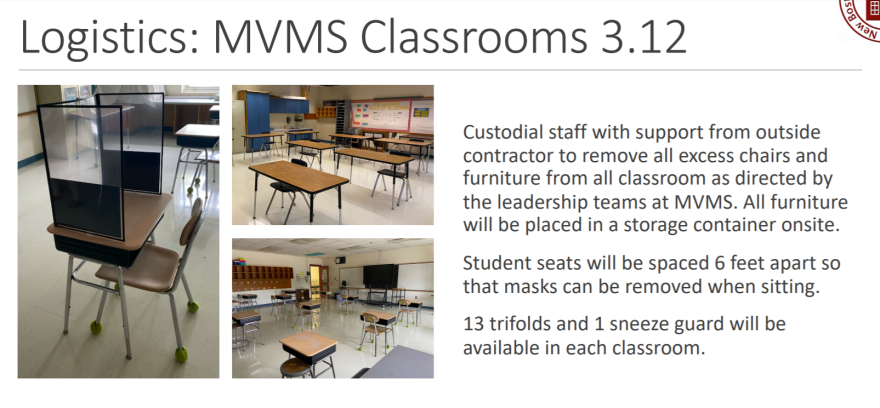Across New Hampshire, parents, teachers and students are getting a first glimpse of what school might look like this fall.
For many, the picture is not as they had hoped.
Despite months of late-night meetings, thousands of surveys, and investment in everything from spray cleaners to medical consultants, many districts admit: There is no single right answer for how to reopen schools during a pandemic.
Related stories:
- Parents Say N.H. Lacks Enough Child Care To Help Them Return to Work
- 'There's No Right Answer': N.H. Schools and Families Grapple With Reopening Plans
Here’s what you should know about how New Hampshire’s schools are reopening, and what major questions remain.
What will New Hampshire's schools look like this fall?
The New Hampshire Department of Education’s reopening guidance stresses flexibility and local control. And with over 100 school administrative units and roughly 30 charter schools, that means the state will see dramatic variation between regions and, in some cases, between neighboring towns.
Reopening plans run the gamut. Some districts - like Somersworth and Dover - plan to start with fully remote models that will have most students working on laptops or with materials sent home. Teachers will work from home or from empty classrooms, and small groups of students with high needs that can’t be met remotely will be allowed in the building for special education and other services.
Other districts - like Rochester, Salem, and Gilford - plan to return to in-person school with new safety measures, such as mask requirements and social distancing. They are also offering a remote option - either run by the district or the Virtual Learning Academy Charter School - for families who do not want their children in school.
And many districts are turning to a so-called "hybrid" model, where students will alternate between remote and in-person instruction, in order to reduce the number of people in the school building at once and maintain social distance more easily.
School leaders emphasize that these plans are provisional; schools may switch modes depending on a potential positive COVID-19 case or outbreak in the building and local infection rates. And they may be able to reopen more fully depending on an effective treatment or vaccine for COVID-19, or if public health experts conclude that transmission among students and their teachers is minimal.
Share your coronavirus questions with us.
What is a hybrid model?

Hybrid models are emerging as one of the most common plans in New Hampshire and in other states that are reopening. But the exact structure will vary significantly by school.
In some schools, students will be sorted by last name; the first half of the alphabet will attend school on Monday and Tuesday, for instance, and the other half will attend on Thursday and Friday. Wednesday will be reserved for remote instruction and cleaning at the school.
In other cases, half of students will attend every morning, while the rest come in the afternoon.
School leaders say the hybrid model will reduce class sizes to allow for social distancing in classrooms and hallways and will make it easier to identify and isolate a cohort of staff or students - rather than the whole school - if someone tests positive for COVID-19.
Do these plans follow the latest public health guidelines?
Yes and no.
Public health experts say reopening should not proceed unless the rate of positive COVID-19 tests in a region remain at 5% or lower for at least two weeks. By that metric, New Hampshire schools can reopen (the state’s positive test rate is hovering at 2%, though its overall testing rate is the lowest in New England.)
But for every metric for reopening, there are hundreds of questions. There is no consensus on what school reopening does to transmission rates. Many public health experts say that young children are unlikely to transmit the virus, so the benefits for them and their parents of returning to school far outweigh the danger. But studies suggest teenagers may be just as likely to spread COVID-19, so middle and high schools may be riskier.
Superintendents in New Hampshire have received conflicting guidance from state and other public health officials on everything from social distancing to the importance of quarantining after out-of-state travel. School nurses say they need greater consistency and clarity on back-to-school protocols.
In many cases, districts’ plans on paper follow the CDC’s and other experts’ advice for reopening: screening staff and students before entering the building, requiring any student or staff member with a COVID-19 symptom to stay home, maintaining a distance of six feet while on school grounds and in the building, requiring cloth face coverings, and instituting strict handwashing and deep cleaning procedures.
But the extent to which schools can enforce any of these rules is still unknown.
In the hybrid model, teachers may be in the building interacting with different cohorts of students throughout the week. Many say that level of exposure is too high, and at least some experts warn that the hybrid model may be far riskier than schools and families would like to believe.

How are teachers and families reacting?
The economic and political fallout of the pandemic, limited daycare options, and continued public health concerns over the coronavirus, have made school reopening contentious in many parts of New Hampshire.
In surveys earlier this summer, a number of districts found that the majority of teachers wanted to stay remote, while the majority of families wanted to send their children back to school. This central tension, school leaders say, means a significant percentage of the school community will disagree with their reopening plan.
In some areas with limited or no positive cases of COVID-19, the debate over school reopening is more muted. But in Milford and Pembroke, pushback from parents against proposals for a fully remote school year have been so strong that district officials went back to the drawing board. In Mascenic, community members have organized a petition against mask rules in the school. And in Rochester, a petition against the district’s in-person plan has garnered over 1,300 signatures.
Homeschooling groups have reported an unprecedented spike in interest, as families opt out of their public school this year because of concerns about uncertain plans, buildings being too restrictive, remote learning being too disconnected, or students and family members getting exposed to the coronavirus.
Many teachers unions are demanding stricter safety guidelines and are hammering out new MOU’s with their district. Others say they are awaiting clarity about whether they can work remotely, given serious underlying health conditions of themselves or a family member.
Teachers who work in one district but send their children to school in another say the patchwork of plans could make coordination close to impossible, particularly if they’re expected to teach in-person while their kids learn remotely.
What has life during COVID-19 been like for you? Tell us here.
What major questions remain before schools reopen?
School districts are still developing protocols for possible and positive COVID-19 cases in the building, and how to communicate them to the school community, given privacy laws.
Districts with hybrid or fully in-person models are scrambling to figure out how many teachers and families want to stay remote, and to what extent they can be accommodated. And they are also assessing technology and internet needs for remote learners and teachers, some of whom struggled to stay connected during the statewide school closure last spring.
Districts are also preparing for a deluge of absentee staff and working to find enough substitute teachers, school nurses, custodial staff, and bus drivers to reopen school.
But then there is a question of cost of pandemic education – to taxpayers, and to the public school system itself. Districts anticipate increased costs if they return to school in full or hybrid form. The state will not have numbers until late fall of how many families have pulled out of their public school and opted for private or home school options. And it may take years to understand the extent to which pandemic education has changed communities’ trust and sense of value in their local public schools.
______________
COVID and The Classroom: NHPR wants to understand how this unusual school year is playing out across the state. Every few weeks, we'll ask you to answer a new question. The latest: How has going back to school been different for you this year? Give us a few examples here to help us tell the story.








